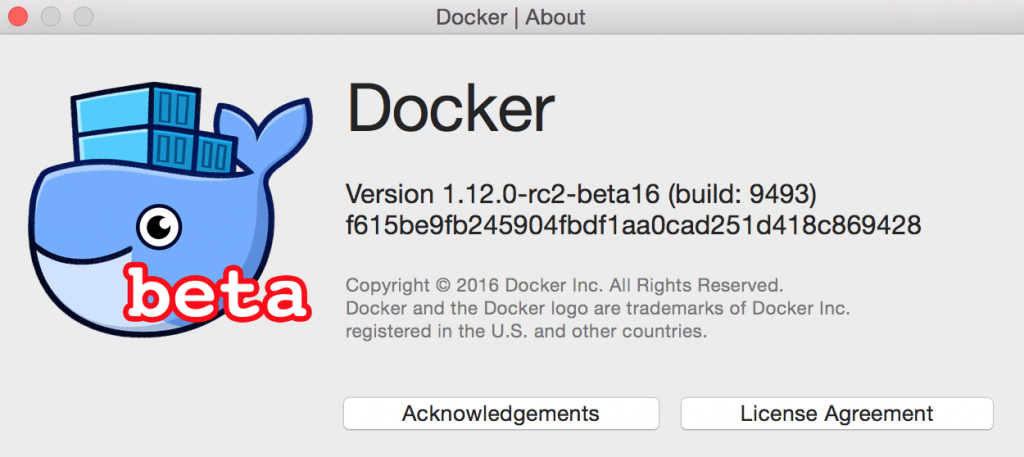


- #Docker for mac docker in docker how to#
- #Docker for mac docker in docker install#
- #Docker for mac docker in docker series#
- #Docker for mac docker in docker download#
The simplest and most common way to use volumes is to bind-mount a host directory when starting a container - that is, to make the directory available at a specified point in the container’s filesystem. For data-at-rest, Docker Volumes offer a flexible mechanism to share data between containers, and with the host. For data-in-motion, Docker offers a variety of ways to connect containers via the network. Isolation as a default encourages careful thinking about the best way to bypass isolation in order to share data with a container.
#Docker for mac docker in docker series#
In the filesystem, isolation shows up as layering: the filesystem of a running container consists of a series of incremental layers, topped by a container-specific read/write layer that keeps changes made within the container concealed from the outside world. Basics of bind-mountingĪ defining characteristic of containers is isolation: by default, many parts of the execution environment of a container are isolated both from other containers and from the host system. in the moby/moby repository symfony (2.7× speedup)Ĭurl of the main page of the Symfony demo app rake (3.5× speedup)įor more details about how and when to enable caching, and what’s going on under the hood, read on. Here’s an illustration of the improvements in a few tools and applications in common use among Docker for Mac users: go list is 2.5× faster symfony is 2.7× faster, and rake is 3.5× faster, as illustrated by the following graphs: go list (2.5× speedup) (Docker users on the stable channel will see the improvements in the forthcoming 17.06 release.) Commands for bind-mounting directories have new options to selectively enable caching.Ĭontainers that perform large numbers of read operations in mounted directories are the main beneficiaries. Any questions? We are here to help! Docker releases (17.04 CE Edge onwards) bring significant performance improvements to bind-mounted directories on macOS. We empower companies to deliver reliable & high-quality software. But, the biggest benefit is, of course, is having a more production-like environment at the tip of your fingers in a few seconds.

In some cases, it might even lessen the need for a cluster running in the cloud, reducing costs. Running Kubernetes through Docker is an interesting option because it removes the need for the minikube virtual machine and the separate minikube binary to manage that.

This should create all the necessary objects for the UI to run properly, which you can check by running kubectl proxy, followed by visiting. No point in running a Kubernetes cluster if we don’t put it to work, right? Let’s start with deploying the Kubernetes Dashboard UI, which is a Kubernetes workload in itself. Kubectl config use-context docker-for-desktop Running our first workload This might take a while, but the dialog will let you know once the Kubernetes cluster is ready.īefore you continue: if you’ve previously used kubectl, you may have to switch the context to your local cluster.
#Docker for mac docker in docker install#
This will start a single node Kubernetes cluster for you and install the kubectl command line utility. Close your currently running Docker daemon if necessary and install the Edge version.Īttention: Switching from Stable to Edge will result in losing all your containers and images! Enabling the local Kubernetes clusterĬlick the Docker icon in the status bar, go to “ Preferences”, and on the “ Kubernetes”-tab, check “ Enable Kubernetes”.
#Docker for mac docker in docker download#
Download the installer from the Docker store.
#Docker for mac docker in docker how to#
In this blog you will learn how to start a local Kubernetes cluster with the latest Docker version.ĭocker with Kubernetes is currently only available on Docker for Mac in the latest Edge version. That is why I was excited to see that in the latest version of Docker it is now possible to run a local Kubernetes cluster. Seeing that Kubernetes appears to be becoming the leading orchestration platform, chances are that the containerized applications you and your team are working on will land on a Kubernetes cluster. Taking control of your environments is a powerful move to make as a scrum team. In many teams, Docker has been an important force behind removing delays in the pipeline to production. Fast feedback loops are instrumental to gaining confidence in changes and achieving a steady pace of delivery.


 0 kommentar(er)
0 kommentar(er)
